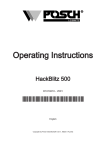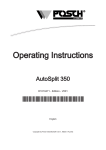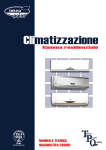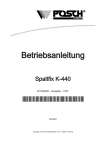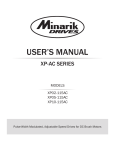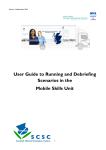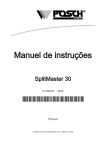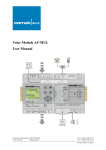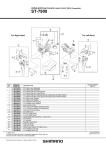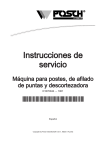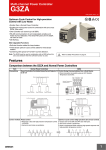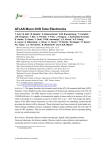Download Spaltfix K-550
Transcript
Operating Instructions Spaltfix K-550 D1010416 - Edition - 1001 *D1010416-1001* English Copyright by Posch Gesellschaft m.b.H., Made in Austria Manufacturer Manufacturer POSCH Gesellschaft m.b.H. Paul-Anton-Keller-Strasse 40 A-8430 Leibnitz Tel.: +43 (0) 3452/82954 Fax: +43 (0) 3452/82954-53 E-mail: [email protected] http://www.posch.com © Copyright by POSCH Gesellschaft m.b.H., Made in Austria Please be sure to fill this in before starting. Then you can be sure that this document relates to your machine, so if you have any queries you will be given the correct information. Machine number:.............................................................................. Serial number:..................................................................................... POSCH Austria: 8430 Leibnitz, Paul-Anton-Keller-Strasse 40, telephone: +43 (0) 3452/82954, fax: +43 (0) 3452/82954-53, e-mail: [email protected] POSCH Germany: 84149 Velden/Vils, Preysingallee 19, telephone: +49 (0) 8742/2081, fax: +49 (0) 8742/2083, e-mail: [email protected] 2 Contents Contents 1 Foreword 5 1.1 Copyright notice 5 1.2 Liability for defects 5 1.3 Reservations 5 1.4 Definitions 5 1.5 Operating instructions 6 2 Safety information 7 2.1 Explanation of symbols 7 2.2 General safety information 7 2.3 Safety instructions for cut-splitters 8 2.4 Safety instructions for conveyor belts 8 2.5 Noise 9 2.6 Remaining risks 9 2.7 Proper use 9 2.8 Incorrect use 9 3 General 10 3.1 Scope 10 3.2 Description 10 3.3 Major machine components 11 3.4 Stickers and their meaning 12 3.5 Set-up 16 4 Start-up 17 4.1 Driven by tractor via universal joint shaft (type PZG) 17 4.2 Powered by diesel engine (Type D) 17 5 Operation 19 5.1 Work operation 19 5.2 Safety bar 26 5.3 Change splitting knife 27 6 Switching off the machine 28 7 Transport 29 7.1 Retract stabiliser feet 29 7.2 Transport position - Conveyor belt 29 7.3 Transport position - Cross conveyor 29 7.4 Raise safety bar 29 7.5 Lock log manipulator 29 3 Contents 4 7.6 Transportation using the travel gear 29 8 Checks 31 8.1 Protective guards 31 8.2 Screw fittings 31 8.3 Hydraulic lines 31 8.4 Oil level 31 8.5 Cutting equipment (harvester) 32 8.6 Chainsaw 33 9 Maintenance 34 9.1 Lubrication 34 9.2 Cutting equipment (Supercut) 35 9.3 Sharpening the saw chain 36 9.4 Changing the chain 39 9.5 General chain care 40 9.6 Replacing the guide bar 40 9.7 Replacing chainwheel 41 9.8 Oil changing 41 9.9 Diesel engine 43 9.10 Cleaning 43 10 Special equipment 45 10.1 Stabiliser feet 45 10.2 Cross conveyor 45 10.3 Conveyor belt 46 11 Additional equipment 49 11.1 Splitting blade variants 49 12 Troubleshooting 50 13 Technical data 51 14 Service 52 EC Declaration of Conformity 53 Foreword 1 Foreword Thank you for buying our product. This machine has been built in conformity with applicable European standards and regulations. These operating instructions explain how to operate the machine safely and efficiently and how to maintain it. Any person entrusted with the transport, installation, commissioning, operation or maintenance of the machine must have read and understood: ▪ the operating instructions ▪ the safety instructions ▪ the safety information given in the individual chapters. To avoid operator error and ensure problem-free operation, the operating instructions must be available to the operating personnel at all times. 1.1 Copyright notice All documents are protected by the law of copyright. Documents including excerpts thereof may not be distributed or reproduced nor may their content be communicated without express permission. 1.2 Liability for defects Read these operating instructions through carefully before putting the machine into operation. We accept no liability for damage or disruptions caused by failure to observe the operating instructions. Claims for liability must be reported as soon as the defect is identified. Claims are null and void for example in the following cases: ▪ improper use ▪ faulty attachments and drives not supplied with the machine ▪ failure to use original spare parts and accessories ▪ conversions or modifications, where not agreed with us in writing We are not liable for defects of wearing parts. 1.3 Reservations Technical data, dimensions, illustrations of the machine and safety standards are subject to continual change and are therefore not in any circumstances binding in relation to the supplied machine. We accept no liability for printing and typesetting errors. 1.4 Definitions Operator The operator is the party which operates the machine and uses it for its intended purpose or causes it to be operated by suitable, trained personnel. Operating personnel 5 Foreword The operating personnel (operators) are those entrusted by the operator to operate the machine. Technical personnel Technical personnel are persons entrusted by the operator of the machine with special tasks such as installation, set-up, maintenance and troubleshooting. Electrician An electrician is a person who, by virtue of his specialist training, has knowledge of electrical systems, standards and regulations and is able to identify and prevent possible hazards. Machine The term machine replaces the commercial designation of the object to which these operating instructions relate (see cover sheet). 1.5 Operating instructions This manual is a "translation of the original operating manual" 6 Safety information 2 Safety information 2.1 Explanation of symbols The following symbols and instructions in this manual provide warnings about possible personal injury or property damage or give useful information about working with the machine. DANGER Warning about danger zones Instruction regarding safe working, where non-compliance entails the risk of serious or fatal injury. Always observe these instructions and ensure that you work with particular caution and care. DANGER Crushing hazard Risk of injury through upper limbs getting trapped. NOTICE Instruction Symbol for proper use of the machine. Non-observance can result in malfunctions by or damage to the machine. Noise Symbol for an area where noise levels can exceed 85 dB(A). Non-observance can cause hearing problems or deafness. Further information Symbol for further information relating to a bought-in part. Information Action-related information. 2.2 General safety information The machine may only be operated by persons who are familiar with the machine's operation and hazards and with the user manual. ▪ It is the operator's responsibility to provide appropriate staff training. Persons under the influence of alcohol, drugs or pharmaceutical products that impair responsiveness must not operate or maintain the machine. 7 Safety information The machine may only be operated if it is in perfect working condition. Only operate the machine if it is in a stable position. Minimum age of operative: 18 years. Only one person may operate the machine at a time. Take regular breaks to ensure concentration. Ensure that your workplace is adequately illuminated since poor lighting can significantly increase the risk of injury. Never work without the protective guards in place. Only carry out repair, setup, maintenance and cleaning work when the drive is switched off and the tool is stationary. ▪ If the machine has a PTO drive, the universal joint shaft must be removed from the tractor. Never leave the machine running unattended. Switch off the machine's drive unit before carrying out any adjustments. Only use original - POSCH - spare parts. Do not modify or tamper with the machine. Machines with combustion engines: DANGER Carbon monoxide formation Suffocation hazard a) Never operate machines in confined spaces! 2.3 Safety instructions for cut-splitters Do not remove offcuts or other parts of the workpiece from the cutting area while the machine is running. Never reach towards the chainsaw with gloves. Only use the machine outdoors. ▪ Should the machine be used indoors, however, a local extractor unit (extraction at source) is required. The machine must always be properly maintained and must be kept free of waste material such as chips and sawn-off pieces of wood. Wear safety shoes and close-fitting clothes when working with this device. Wear protective gloves. Use respiratory protection to reduce the risk of inhaling harmful dust. When turning off the machine, always be careful of the tool runout until the machine has come to a standstill. The working pressure of the hydraulic system must not exceed 300 bar. 2.4 Safety instructions for conveyor belts Persons must keep clear of the danger zone. It must be expected that material will be ejected at high speed to any position within this area. Never reach into the hopper or touch the conveyor belt when the machine is running. Shut the drive down before removing any jammed pieces of wood. Only use the machine outdoors. 8 Safety information Wear safety shoes and close-fitting clothes when working with this device. Wear protective gloves. The working pressure of the hydraulic system must not exceed 300 bar. 2.5 Noise In machines with an internal combustion engine an A-rated emission sound pressure level of 95 dB(A), measured at the operative's ear, should be expected. The workplace-related, A-rated emission sound pressure level is ▪ 80 dB(A) when idling or ▪ 95 dB(A) when sawing, measured at the operative's ear. In the case of machines with a PTO drive, the noise level depends on the noise of the tractor. Ear protection is therefore necessary. The stated values are emissions values, and thus do not necessarily represent reliable values for the work area. Although there is a correlation between emission and pollutant levels, it is not possible to deduce reliably from that whether or not additional precautionary measures are necessary. Factors that influence the level of pollutants present in the work area include the individual nature of the work area, other sources of noise, e.g. the number of machines and other work operations being carried out in the vicinity. Equally, permissible values for a work area may vary between different countries. However, this information should enable the user to estimate the dangers and risks more accurately. 2.6 Remaining risks Even if all safety precautions are observed and the machine is used in accordance with the instructions, some risks still remain: ▪ Touching of revolving parts or tools. ▪ Injury caused by flying logs or log pieces. ▪ Risk of burns if the engine is not properly ventilated. ▪ Hearing loss if ear protection is not worn when working. ▪ Human error (e.g. due to excessive physical exertion, mental strain, etc.) With every machine, some risks still remain. Therefore you should always be very careful when working. It is up to the operating personnel to ensure that work is carried out safely. 2.7 Proper use The Spaltfix K-550 is a cutting and splitting machine for logs with a diameter of 10 - 55 cm. It splits logs with a splitting force of 36 t or 41 t into 2 to 18 sections. The section length is adjustable from 25 - 100 cm. The machine may only be used to process firewood. 2.8 Incorrect use Any incorrect use or use other than that specified under "Proper use" is expressly forbidden. 9 General 3 General 3.1 Scope This user manual applies to the following machines: Machine type Item no.* M3705 M3745 Type Spaltfix K-550 - PZG Spaltfix K-550 - D100 Drive PTO shaft Diesel engine *The article number is stamped on the machine's rating plate. Models Special equipment SO380 SO390 SO381 SO384 SO438 SO385 SO389 Tractor chassis, 10 km/h with hydraulic stabiliser feet Tractor chassis, 10 - 25 km/h with hydraulic stabiliser feet and air brake system Road chassis, 80 km/h with hydraulic stabiliser feet and ABS brake system Conveyor belt 2.5 m, hydraulic drive Conveyor belt 3.5 m, hydraulic drive Conveyor belt 5 m, hydraulic drive Conveyor belt 6 m, hydraulic drive Additional equipment F0002549 Tank heating F0001678 Splitting knife, 4-section F0001674 6-billet splitting blade F0001694 8-billet splitting blade F0001679 Ring splitting knife 210, 12-section F0001680 Ring splitting knife 250, 15-section F0001672 Ring splitting knife 250, 18-section F0001673 Ring splitting knife 300, 18-section 3.2 Description The Spaltfix K-550 machine is a firewood processing machine which is used to cut and then split firewood. The log is cut in a horizontal position and is held in place with the claw while being cut. The log is then cut to length by the hydraulically driven Harvester chainsaw. The chainsaw is lubricated with chainsaw oil during the cutting process. Once the log has been cut, it is tipped forwards by the tilting mechanism and drops into the splitting trough. The ram of the hydraulic splitter advances and presses the log against the splitting knife. The hydraulically height-adjustable splitting knife allows the optimum setting to be achieved in any operating situation. A choice of options is available for discharging the split logs, e.g. via a conveyor belt. 10 General Operation of the hydraulic ram is semi-automatic. The cutting and splitting tool is hydraulically driven. The machine is driven by a pto or a diesel engine. 3.3 Major machine components 11 12 10 10 9 8 7 6 5 4 3 2 1 13 14 15 16 17 18 19 20 21 22 23 26 1 2 3 4 5 6 7 8 9 10 11 12 13 25 24 Wood trough Chain conveyor Hydraulic tank Rating plate Chainsaw oil tank Controls Guard bar Chainsaw Claw Log diameter display Safety grille Conveyor belt Belt conveyor stabiliser foot 14 15 16 17 18 19 20 21 22 23 24 25 26 Light barrier Splitting knife Tilting mechanism Splitter Base Wheel Diesel engine switchgear cabinet Controller switchgear cabinet Steps Diesel engine Hydraulic stabiliser foot Base frame Drawbar 11 General 3.4 Stickers and their meaning 7 6 8 11 Z2001157 10 5 10 20 2 Z205 0400 9 12 30 4 40 Z205 0679 50 55 Z200 1360 3 Z200 1256 Z205 0561 1 Z200 1260 11 13 14 Z205 0400 Z200 1173 Z200 1162 max. 8,5 bar 16 5 m 18 Z204 0385 -1 n = 440 min 16 min 15 -1 n = 480 min max Z200 1240 1 2 3 4 5 6 7 8 9 10 11 12 13 14 15 16 12 Z200 1220 Hydraulic oil Hydraulic oil level Wear goggles and ear defenders Wear protective gloves Only carry out repair, setup, maintenance and cleaning work when the drive is switched off and the tool is stationary. Only one person may operate the machine at a time Always read the user manual before operating the machine Caution, moving tools Wear safety shoes Chain oil Lubrication point Log diameter Grease tool guide Danger zone (at belt conveyor) Tyre pressure Operation - stabiliser feet General 17 18 Rotational direction of pto Maximum pto speed 3.4.1 Stickers on controls 5 1 2 7 6 8 4 3 9 10 28 Z200 1231 11 27 12 26 13 Z200 Z200 1229 1229 25 14 15 24 23 1 2 3 4 5 6 7 8 9 10 11 12 13 14 22 21 Advance cross conveyor chain Claw to left Advance tilting mechanism Lock claw advance (on lever) Retract conveyor belt Raise cross conveyor Raise conveyor belt Open conveyor belt Close conveyor belt Lower conveyor belt Lower cross conveyor Conveyor belt on Claw to right Saw 20 19 15 16 17 18 19 20 21 22 23 24 25 26 27 28 18 17 16 Lock claw (on lever) Retract cross conveyor chain Log manipulator downwards Split Splitting knife downwards Safety grille downwards Retract tilting mechanism Splitting knife to right Shorter wood Longer wood Splitting knife to left Raise splitting knife Raise safety grille Raise log manipulator 13 General 3.4.2 Stickers on control unit 5 1 2 6 7 4 3 B Z2001194 Z204 0380 A Z2001193 8 9 10 Z204 0375 11 Z204 0370 12 1 2 3 4 5 6 7 8 9 10 11 12 13 14 15 16 14 13 Splitter - manual/automatic Start machine Advance splitter Retract splitter Operating pressure of splitter (on ram side) Operating pressure of splitter (2nd cylinder) Operating pressure of chainsaw Counter - splitting operations Control voltage present Counter - operating hours Speed of saw advance Safety loop - OK Splitter at front Splitter at rear Splitting knife in adjustment range Default position - tilting mechanism 14 15 16 General 3.4.3 Labels on the cross-conveyor Z205 0400 1 Z200 1204 Z200 1246 3 max. 1,5 t 1 1m 2 Z205 0400 1 2 3 Lubricating point Maximum weight load Danger zone 3.4.4 Stickers on belt conveyor 1 2 Z200 1246 Z205 0400 .3 max 3 5˚ Z200 1206 15 General 1 2 3 Lubrication point Danger zone Max. angle of conveyor belt 3.5 Set-up Ensure the machine is stable before starting it. Set up the machine on a level, firm and clear work surface. The machine must be placed directly on the ground. Do not place wooden boards, flat pieces of metal etc. underneath it. 3.5.1 Lower stabiliser feet Please see ... Stabiliser feet [➙ 45] 3.5.2 Working position - Conveyor belt ▪ See: Conveyor belt [➙ 46] 3.5.3 Working position - Cross conveyor ▪ See: Cross conveyor [➙ 45] 3.5.4 Unlock log manipulator Please see ... Log manipulator [➙ 22] 3.5.5 Lower safety bar Please see ... Safety bar [➙ 26] 16 Start-up 4 Start-up Before starting to operate the machine, please check that the protective and safety systems are working and also the hydraulic hoses and oil level. 4.1 Driven by tractor via universal joint shaft (type PZG) ▪ Attach the universal joint shaft and secure with the safety chain. ▪ Clockwise rotation of the tractor PTO shaft. ▪ Turn the tractor's manual throttle to minimum. ▪ Slowly engage the tractor PTO shaft and allow the machine to start moving. ▪ Set the required PTO speed using the manual throttle. Maximum PTO shaft speed: ▪ 480 rpm The maximum PTO shaft speed must on no account be exceeded, otherwise the oil will become too hot. This leads to premature wear and leaks in the pump, cylinder and hydraulic pipes. Before disengaging the universal joint shaft, set the manual throttle of the tractor to minimum. The universal joint shaft must be stored in the universal joint shaft linkage when it is disconnected. 4.1.1 Connecting the power supply ▪ Connect the 7-pin plug to the tractor. Supply voltage 12 V 16 A continuous current ▪ 20 A continuous current for machines with crane ▪ Switch on lights on tractor (depending on model). 4.2 Powered by diesel engine (Type D) Check the oil level before starting the engine. 17 Start-up 4 6 3 OFF ON START 1 5 1 2 3 2 Mode switch Speed regulator Ignition switch 4 5 6 Preheat indicator Fuel gauge Engine display 1. Insert and turn on the battery main switch. – This is located in the engine compartment on the battery cover plate. 2. Set the mode switch to "Manual". 3. Set the speed regulator to "Minimum". 4. Turn the ignition switch to "ON". – Preheating takes place automatically (indicator lights up). 5. When the indicator goes off, turn the ignition switch to "Start". 6. When the engine starts, let go of the ignition switch. 7. Set the desired speed with the speed regulator or switch to "Automatic mode". – In automatic mode the engine automatically goes to maximum speed when a hydraulic function is activated. Engine information: Engine Fuel Tank capacity D100 diesel 180 litres Consumption approx. 8 to 10 l/h For further information, refer to the operating instructions supplied with the engine. 18 Operation 5 Operation At outdoor temperatures below 0°C, let the machine idle for approximately five minutes to allow the hydraulic system to reach the correct operating temperature (the hydraulic pipes will then be warm to the touch). 5.1 Work operation Only one person may operate the machine at a time. Ensure that no other people are in the vicinity of the machine. 1. Start the machine. 2. Turn on the main switch at the switch cabinet. – See: Switch cabinet [➙ 23] 3. Turn on the controller ("Start system"). – See: Control box [➙ 24] 5.1.1 Operation of claw, saw and tilting mechanism 1 4 2 3 1 2 Tilt Claw - left 3 4 Saw Claw - right ▪ Using the control lever (Claw - right) move the log as far as the wood stop. ▪ There are also additional functions available at the control lever: – If you press the right tilt key, the claw advance is locked (to hold the log more firmly). – If you press the left tilt key, the claw is locked (to retract the log). ▪ Pull the control lever towards you (Saw) and saw through the log. The chain is lubricated with chainsaw oil at the same time. Never work without chain lubricating oil. ▪ Hold the lever towards you until the log has been completely sawn through. The saw advance rate can be adjusted to the wood being cut. ▪ Please see Set saw advance rate [➙ 21] ▪ Use the control lever (Tilt) to move the sawn log to the splitting area. Ensure that the log is configured longitudinally to the splitting knife. 19 Operation 5.1.2 Operating the splitter and splitting knife 4 1 3 5 2 1 2 3 Splitting knife - up Splitting knife - down Split 4 5 Splitting knife - retract Splitting knife - advance ▪ Use the control lever (Split) to initiate a splitting stroke (push the lever briefly to the right). The log is pressed against the splitting knife and split. ▪ There are also additional functions available at the control lever: – If you press the left tilt button, the roll grille opens (e.g. to align the log). – If you press the right tilt button, the roll grille closes. The splitting knife can be adjusted (to set the split centre point). ▪ Read off the log diameter at the claw and set using the control lever (Splitting knife - up/ down) according to the scale at the splitting knife. ▪ Set the centre point of the splitting knife from the side adjustment area using the control lever (Advance/retract splitting knife). 20 Operation 5.1.2.1 Left-over wood 1 1 Retract tilting mechanism If the left-over wood is too short to split, it can be ejected to the rear using the tilt function. Eject the left-over wood by pressing the control lever (1) to the left. Machines with a crane do not have a left-over wood ejection facility. 5.1.2.2 Notes on splitting Only use logs up to a diameter of 10 - 55 cm. Remove jammed wood from the splitting blade with a striking tool. 5.1.3 Set saw advance rate - + ▪ Increase advance rate: Turn the throttle anti-clockwise. ▪ Reduce the advance rate: Turn the throttle clockwise. 21 Operation 5.1.4 Set log length 1 2 1 Long log 2 Short log The log length is infinitely variable within the range 25 - 100 cm. Set the desired log length using the control lever (Long/short log). ▪ The log length can be read off on the length scale. Machines with conveyor belt: For log lengths in excess of 50 cm the conveyor belt must be lowered until it is horizontal to prevent damage to the conveyor belt. Where the log length exceeds 50 cm only 4-, 6- and 8-section splitting knives may be used. 5.1.5 Log manipulator 1 2 22 Operation 1 Log manipulator arm 4 Lock Working position: Rotate the lock to the rear until it engages. Transport position: Rotate the lock to the front until it engages. The log manipulator arm is secured against accidental lowering. Log manipulator operation 1 2 1 Retract log manipulator arm 2 Advance log manipulator arm Use the control lever (Advance/retract log manipulator arm) to move the log to the right position. 5.1.6 Electrical functions 5.1.6.1 Switchgear cabinet 2 8 9 7 6 4 5 3 1 1 2 Master switch LED - control voltage present 6 7 3 4 5 LED – safety loop OK LED – splitting knife position LED – splitter at rear 8 9 LED – splitter at front LED – tilting mechanism default position Counter - splitting operations Counter - splitting operations The following functions are available on the front of the switchgear cabinet: ▪ The master switch (1) for supplying power to the 12 V electrics. 23 Operation ▪ LED (2) lights up if the 12 V power supply is available. ▪ LED (3) lights up if the safety loop is available. – The loop is closed if no emergency stop function has been actuated. ▪ LED (4) lights up if the splitting knife is in the range of the side adjustment. – This position is monitored to prevent damage to the splitting knife or mount. ▪ LED (5) lights up if the splitter is at the rear. ▪ LED (6) lights up if the splitter is at the front. ▪ LED (7) lights up if the tilting mechanism is in the centre position. – If it is not in this position, no splitting stroke is initiated. ▪ The counter (8) counts the splitting operations performed by the machine. ▪ The counter (9) counts the operating hours worked by the machine. 5.1.6.2 Control unit 1 2 3 1 2 4 Switch - manual/automatic splitter operation Button (green) - start machine 3 Button (yellow) - retract splitter 4 Button (yellow) - advance splitter The control unit has one switch and 3 buttons: Press button (2) to switch the electrical system on. ▪ The button lights up green; if not, see page [➙ 25]. You can choose between operating the splitter in manual or automatic mode with switch (1). ▪ Manual mode: In manual mode you can move the splitter in stages using buttons (3) and (4), e.g. if a log is jammed. ▪ Automatic mode: Once you have actuated the (Split) [➙ 20] control lever, the splitter automatically advances to its end position and then retracts to its starting position. 24 Operation 5.1.6.3 Stop function 3 2 1 1 2 Stop button Roll grille 3 5 Guard bar The machine has 3 Stop functions. Actuating the Stop function switches off all safety-related drives. This affects the: ▪ Chainsaw ▪ Splitter 1st stop function: by operating the Stop button on the control panel. 2nd stop function: by opening the splitter system roll grille. 3rd stop function: by raising the safety bar at the rear of the machine. Before you can continue working with the machine, the Stop function must first be deactivated: ▪ Unlock the Stop button, close the roll grille, lower the safety bar. ▪ Press the (Start machine) [➙ 24] button - button lights up green - machine is ready. 5.1.6.4 End switches The inductive end switches have an LED for monitoring purposes. ▪ Green LED ..... 12 V control voltage present ▪ Yellow LED ..... switching state - on 5.1.6.5 Malfunctions Fault No 12V supply voltage present Machine cannot be switched on Splitter does not advance The inductive end switches do not light up Cause With type PZG, plug not connected to tractor Fuses (F1/F2) in switchgear cabinet faulty Supply cable to switchgear cabinet faulty No 12V supply voltage present Check safety end switches (emergency stop button, roll grille, safety bar) for contact and cable break Tilting mechanism not in centre position Splitting knife not in adjustment range of side adjustment No 12V supply voltage present 25 Operation Fault Cause End switch(es) not set correctly (gap 3 – 5 mm) End switch(es) faulty or cable break 5.2 Safety bar 1 3 2 4 1 2 Cross conveyor Clip pin 3 4 Safety bar Cotter pin Lower safety bar: 1. Lower the cross conveyor. 2. Release the right clip pin. 3. Raise the safety bar slightly and withdraw the cotter pin. 4. Lower the safety bar as far as the stop. Raise safety bar: ▪ Proceed as described above but in reverse order. 26 Operation 5.3 Change splitting knife 6 5 3 4 2 1 1 2 3 Piece of wood Cylinder screw Cylinder 4 5 6 Connecting panel Lift bracket Eye 1. Place a piece of wood under the splitting knife. 2. Lower the splitting knife onto the wood. ▪ The piece of wood should be high enough to ensure that the cylinder screw is in the centre of the slot. 1. Remove the connecting panel by releasing the 4 screws. 2. Loosen the 4 screws on the lift bracket. 3. Pull the entire lift bracket forwards. 4. The splitting knife can be withdrawn upwards by connecting a crane or front loader etc. to the lifting eye. Grease the new splitting knife before fitting it. 27 Switching off the machine 6 Switching off the machine Before switching off the machine, depressurise all hydraulic functions by placing all control levers in the neutral position. Driven by tractor via cardan shaft (type PZG) Disengage the cardan shaft on the tractor. ▪ Before disengaging, turn the manual throttle to minimum. Powered by diesel engine (Type D) Set the diesel engine to idle and let it run for a few minutes to allow the engine to cool down, then switch it off (see engine operating instructions). 28 Transport 7 Transport 7.1 Retract stabiliser feet Please see ... Stabiliser feet [➙ 45] 7.2 Transport position - Conveyor belt ▪ See: Conveyor belt [➙ 46] 7.3 Transport position - Cross conveyor ▪ See: Cross conveyor [➙ 45] 7.4 Raise safety bar Please see ... Safety bar [➙ 26] 7.5 Lock log manipulator Please see ... Log manipulator [➙ 22] 7.6 Transportation using the travel gear Tractor travel gear ▪ Attach the towbar to the tractor. ▪ Crank up the jockey wheel. ▪ Release the parking brake. ▪ Check tyre pressure - max 3.5 bar. ▪ Plug the lighting system plug into the tractor. ▪ Check that the lighting system is working properly. Observe the road traffic regulations when driving on public highways. Maximum transport speed: 6 km/h (10 km/h) - Observe local regulations. When the machine is uncoupled from the tractor, it must be placed on a firm, level surface. 29 Transport Lorry travel gear ▪ Attach the towbar to the tractor. ▪ Crank up the jockey wheel. ▪ Plug the lighting system plug into the tractor. ▪ Check that the lighting system is working properly. ▪ Check tyre pressure - max 3.5 bar. Observe the road traffic regulations when driving on public highways. Maximum transport speed: 80 km/h When the machine is uncoupled from the tractor, it must be placed on a firm, level surface. 30 Checks 8 Checks Before carrying out any checks on the machine, the drive unit MUST be switched off! 8.1 Protective guards All the protective guards (covers, safety grilles, etc.) must be in place. 8.2 Screw fittings Tighten all screws and nuts after the first hour of operation. Tighten the screws and nuts after every 100 hours of operation. ▪ Replace missing screws and nuts. 8.3 Hydraulic lines After the first hour of operation, check that all hydraulic connections are secure and are not leaking. Check that all hydraulic connections are secure and are not leaking after every further 100 hours of operation. ▪ Damaged hydraulic lines must be replaced immediately. 8.4 Oil level To check the oil level place the machine on an even surface. Check the oil level with the pusher retracted. 8.4.1 Hydraulic oil level When the oil sight glass is filled above halfway, the oil level is at its maximum. When the oil level is towards the bottom of the oil sight glass, the oil level its at its minimum. If this is the case, the hydraulic oil must be topped up immediately. ▪ See: Changing the hydraulic oil [➙ 41] The oil filter only needs to be checked when the oil is changed. 8.4.2 Chain lubrication oil Never work without chain lubrication. The oil level can be monitored as the tank is transparent. 31 Checks Recommended chain lubrication oil: Manufacturer Fuchs Type Plantotac Bio Total filling capacity 30 litres , 13 litres (for machines with crane) Any other biologically degradable chain lubrication oil can be used, provided it is of the following viscosity: ▪ 50 - 75 at 40° C ▪ 10 - 20 at 100° C 8.4.3 Transmission oil level 1 2 3 1 2 Oil inlet screw Oil level screw 3 Oil drain screw If the oil seeps out of the hole of the oil level screw when the machine is on level ground, the maximum oil level has been reached. If the oil level is below the hole, this is the minimum oil level. If this is the case, the transmission oil must be topped up immediately. ▪ See: Changing the transmission oil [➙ 43] 8.5 Cutting equipment (harvester) Daily: ▪ Fastenings and hydraulic hoses. ▪ That no damage or breakages have occurred to the saw unit. ▪ Saw chain check. ▪ Chain lubrication oil tank level check. Check every 8 - 20 operating hours, regardless of operating conditions: 32 Checks ▪ Saw unit lubrication at lubrication point with mineral-oil-based grease. 8.6 Chainsaw 8.6.1 Saw chain Check the cutting performance of the chain. ▪ If the chain is not properly sharpened, cutting performance will be compromised. ▪ Dull chains produce sawdust, sharp chains produce chips. Posch chainsaw: The chain tension should be such that the chain can be raised by 4-5 mm in the centre of the chain bar. Supercut chainsaw: Chain tension is established automatically during operation. 8.6.2 Chainwheel If the chain wheel shows signs of digging-in on the teeth it requires replacing. Otherwise the service life of the chainsaw will be reduced. 33 Maintenance 9 Maintenance Before carrying out any maintenance on the machine, the drive unit MUST be switched off! Never work without the protective guards in place. Only use original - POSCH - spare parts. 9.1 Lubrication Dispose of oily and greasy parts and oil residues in accordance with legal regulations. 9.1.1 Lubrication schedule C A B E D F 1 2 3 1..........Mineral oil grease, 2..........Multi-purpose grease, 3..........Spray oil Lubrication intervals Daily Weekly (every 40 operating hours - or less depending on application) 34 Item A B C What/where Guides on the splitter (central lubricating header) Cutting head on saw unit All lubricating points on the gripper Maintenance Lubrication intervals Item D What/where The sliding surfaces on the splitting blade adjuster E On the feed table, the cylinder mounting and the feed table mounting F The housing bearings and chainwheels on the cross conveyor not The cylinder mounting and the housing bearings illustrated on the conveyor belt Monthly (every 160 operating hours - or less depending on application) The lubrication points are marked with the lubricate symbol. Recommended lubricating greases: Manufacturer Genol Fuchs Type Multi-purpose grease Multi-purpose grease 5028 9.2 Cutting equipment (Supercut) 9.2.1 Cleaning the check-valve (outlet) 1 2 3 1 2 Check-valve key Check-valve 3 Lubricating oil pump 1. Remove hose and elbow fitting from the lubricating oil pump. 2. Remove the check-valve with the check-valve key. 3. Check the check-valve for deposits and clean or replace if necessary. 4. Ensure that there is no dirt in the lubricating oil pump. 5. Refit the check-valve. 6. Fit the hose and elbow fitting back on. 35 Maintenance 9.2.2 Cleaning the inlet filter and check-valve (inlet) 1 2 3 4 5 1 2 3 Filter Compression spring Plug 4 5 Check-valve (inlet) Allen key 4 mm 1. Remove hose from the plug. 2. Undo plug using a 32 mm screwdriver. 3. Remove compression spring and filter. 4. Clean or replace filter if necessary. 5. Undo the check-valve (inlet) with a 4 mm Allen key and take it out. 6. Clean the check-valve or replace if necessary. 7. Refit the removed components. 8. Replace hose. 9.3 Sharpening the saw chain When sharpening the chain the following dimensions should be borne in mind to achieve optimum chain sharpness. The following dimensions refer to the chain used on this machine. ▪ Oregon 18HY-86E Only use a chain and guide bar made by the same manufacturer. 9.3.1 Top plate angle The top plate angle is 35°. This must be the same on all cutting teeth. DIfferent cutting angles can lead to a raw, uneven chain action and increased wear on the chain. 36 Maintenance 9.3.2 Side plate angle The cutting edge sloping away from the tooth point is called the side plate. ▪ On the Oregon chainsaw this angle is 85°. ▪ When sharpening using the file guide this angle is automatically created. 9.3.3 Top-plate cutting angle The top plate cutting angle is 60°. ▪ When sharpening using the file guide this angle is automatically created. 9.3.4 File guide When sharpening the file must be parallel to the tooth point and moved at an angle of 110° to the side of the chain links. 37 Maintenance 9.3.5 Sharpening the cutting edge A file guide is recommended when sharpening by hand. This ensures the file remains at the right angle in relation to the tooth. ▪ Only special chain files with a diameter of 5.5mm may be used. The cutting edges must always be filed from the inside to the outside. All cutting teeth must be of the same length. Because of the form of the tooth point (i.e. sloping downwards - front clearance angle), if the teeth are of different lengths then teeth will also be of different height. ▪ Teeth of different heights can lead to a rough chain action and possible chain breaks. ▪ The shortest tooth must therefore be measured and sharpened first. The remaining teeth must then be filed back to this length. All teeth are first filed on one side, then on the other. Work quickly. Ensure that you only file on the forwards stroke. When drawing back the file must be lifted up. ▪ The connecting and drive links must never be filed. In order to prevent the file from becoming worn on one side, it should be turned frequently. It is preferable to sharpen more often, taking away a little metal at a time. Only two or three strokes are required when sharpening. 9.3.6 Depth gauge The depth gauge determines the depth of bite into the wood, i.e the thickness of chips. ▪ The depth is 1.2 mm. After sharpening the teeth the depth gauge is reduced. This must then be checked using a special file gauge. 38 Maintenance If the depth extends over the file gauge it must be filed back using a flat or triangular file. 9.3.7 Automatic chain sharpeners Automatic chainsaw sharpeners can be purchased at your specialist dealer. These offer precise chain sharpening. 9.4 Changing the chain 6 1 5 2 7 3 4 1 2 3 4 Guide bar Locking button Slackening button 1 Chainwheel 5 6 7 Guide screw Chain Slackening button 2 Wear protective gloves when working on the chainsaw to prevent cuts. 1. Press the slackening button 1 (lower button on rear) and the slackening button 2 (on the right of the plate) at the same time to slacken the chain. 2. Pull on the chain. – The guide bar is slackened. 3. Press the locking button (top button on the rear) and pull on the chain until the locking button clicks into place. 4. Now the chain can be removed. 5. Blow out the oil supply holes and the chain rail in the guide bar with compressed air. 6. Check the depth of the chain rail. 39 Maintenance – The minimum depth for the chain rail is 7 mm. This prevents the drive links from grinding on the base of the rail. – If this the depth falls below this minimum the guide bar must be replaced. 7. Reinstall the guide bar, having turned it round 180°. This prevents the guide bar from becoming worn on one side, as it is exposed to the most wear on the underside. 8. Place the new chain on the guide bar. – New chains should never be placed on a broken-in (used) chainwheel. – The chainwheel must be changed after a maximum of two chains. Recommended chains: Oregon 18HY-86E Drive link thickness: 2 mm Number of drive links: 86 Before fitting the chain, soak it overnight in lubricating oil, allowing it to penetrate all links. Ensure that the cutting edges of the parts on the upper side of the rail point towards the guide bar head. 9. Pull on the chain briefly, so that the chain locking button clicks into place and release the chain slowly back onto the guide bar. – Chain tension is established automatically during operation. 9.5 General chain care Before fitting a new chain, soak it overnight in lubricating oil, allowing it to penetrate all links. After sharpening clean the chain thoroughly in petrol to remove any swarf caused by filing. Then lubricate the chain in an oil bath. When cleaning or sharpening check the chain for tears in the links or damaged rivets. Replace any damaged or worn parts. ▪ The new parts must be of the same size and format as the existing chain parts. During long periods of disuse the chain should be cleaned with a brush and placed in an oil-petroleum bath. Each new chainsaw requires a short running-in time of approx. 2-3 minutes before cutting work can begin. 9.6 Replacing the guide bar 1. Remove the chain. 2. Undo the guide screws on the rail holder and remove the guide bar. 3. Fit a new guide bar and retighten guide screws. 40 Maintenance 9.7 Replacing chainwheel Nord-Lock ! 4 3 2 1 1 2 Acorn hexagon head bolt Nord-Lock washer 3 4 Chain catcher Chainwheel 1. Remove the chain. 2. Undo the acorn hexagon head bolt. 3. Remove the Nord-Lock washer and the chain catcher. – The chainwheel can now be removed. 4. Fit the new chainwheel. 5. Carefully clean the acorn hexagon head bolt and the threaded hole in the shaft or the saw engine. 6. Apply some "Loctite 243" to the acorn hexagon head bolt. 7. Fit the chain catcher back on and tighten the acorn hexagon head bolt with the NordLock washer. It is essential to use the Nord-Lock washer – no other type of lock washer must be used. 9.8 Oil changing Old oil must be disposed of in an environment-friendly manner. Find out about the environmental regulations in your country. 9.8.1 Changing the hydraulic oil Carry out the first oil change after 500 hours of operation. Thereafter change the oil at least once per year. An oil change is not required any earlier as we carry out a secondary flow filtration during the final check where all dirt particles are removed. ▪ Cleanliness test in line with ISO 4406: cleanliness class 14/11 fineness 1.2 ym / oil load - low. Changing procedure: ▪ Retract the pusher before changing the oil. 41 Maintenance ▪ Open the filler cap. ▪ Open the oil drain screw. The oil drain screw is located on the base of the oil tank. ▪ Drain the old hydraulic oil into a container. ▪ Screw the oil drain screw back into the tank and fill with new hydraulic oil. ▪ Turn on the machine and allow it to run for a short while. ▪ Check the oil level and top up hydraulic oil if necessary. Total filling capacity of the hydraulic system: Quantity 350 litres Our hydraulic system is filled with high-quality OMV ATF II transmission fluid. ▪ This oil has an extremely high viscosity index, exhibits excellent foaming and aging characteristics and excellent flow properties at low temperatures and protects reliably against wear and corrosion. ▪ Viscosity class ISO VG 46. This high-quality oil comes highly recommended when changing the oil. A mixture of products of the same quality poses no problem. 9.8.1.1 Recommended hydraulic oils Manufacturer OMV SHELL ELF ESSO CASTROL ARAL GENOL FUCHS Oil specification ATF II Donax TA Hydrelf DS 46 Univis N46 Hyspin AWH-M 46 Vitam VF46 Hydraulic oil 520 Platohyd 32S * / Renolin B46 HVI *.....biological hydraulic oils 9.8.2 Oil filter 1 2 1 Filter cover 2 Filter insert The filter insert should be changed every time the oil is changed. Any aluminium particles can be disregarded, as these occur when the pump is running in. 42 Maintenance Do not wash out the filter insert with petrol or paraffin products as these damage it. 9.8.3 Changing the transmission oil The first oil change should be carried out after 100 operating hours, further oil changes should then be carried out every 500 operating hours or yearly. 1 2 3 1 2 Oil inlet screw Oil level screw 3 Oil drain screw ▪ Unscrew the oil inlet and oil drain screw. ▪ Let the old oil drain out, then replace the oil drain screw. ▪ Add the new transmission oil. ▪ Check oil level. Total filling capacity 0.5 litres Any other transmission oil can be used, so long as it is in viscosity class SAE 90. 9.8.3.1 Recommended transmission oils Manufacturer OMV GENOL FUCHS Oil specification Gear Oil MP SAE 85W-90 Gear oil MP 90 Titan Gear Hypoid SAE 90 9.9 Diesel engine For maintenance operations, refer to the engine operating instructions. 9.10 Cleaning Before carrying out any cleaning work on the machine, the drive unit MUST be switched off! Clean the machine regularly to ensure proper operation. Only wash new machines (during the first 3 months) with a sponge. 43 Maintenance ▪ The paint is not yet completely set, so cleaning with a high pressure cleaner may damage the finish. 44 Special equipment 10 Special equipment 10.1 Stabiliser feet 1 2 3 4 1 3 5 7 2 4 6 8 Raise front right stabiliser foot Lower front right stabiliser foot Raise front left stabiliser foot Lower front left stabiliser foot 5 6 7 8 Raise rear right stabiliser foot Lower rear right stabiliser foot Raise rear left stabiliser foot Lower rear left stabiliser foot Lower stabiliser feet: 1. Lower the hydraulic stabiliser feet using the control levers. 2. Keep lowering until the machine is lifted off its wheels and is aligned horizontally. Retract stabiliser feet: Proceed as described above but in reverse order. 10.2 Cross conveyor Several logs can be placed on the cross conveyor at once. 10.2.1 Lower cross conveyor 1. Unlock the cotter pin for the transport bracket. – Withdraw the spring cotter for the transport bracket, pull down the cotter pin and fit the spring cotter again. 2. Withdraw the cotter pin for the stabiliser foot. – To do so, remove the spring cotter for the stabiliser foot. 3. Swing the stabiliser foot out and relocate the cotter pin in the bore. – Refit the spring cotter. 4. Using the control lever, lower the cross conveyor to the ground. 45 Special equipment 10.2.2 Operation - cross conveyor 1 3 2 4 1 2 Cross conveyor chain - retract Cross conveyor chain - advance 3 4 Cross conveyor - lower Cross conveyor - raise Using the control lever (Cross conveyor - advance) move the log into the claw trough. 10.2.3 Raise cross conveyor Proceed as described above for lowering the cross conveyor but in reverse order. 10.3 Conveyor belt 10.3.1 Conveyor belt types Conveyor belt type 2,5 3,5 5 6 46 Conveyor belt length 250 cm 350 cm 500 cm 600 cm Conveyor height 140 cm 190 cm 260 cm 310 cm Belt width 80 cm 80 cm 80 cm 80 cm Special equipment 10.3.2 Operation - conveyor belt 1 3 2 4 5 6 1 2 3 Raise conveyor belt Lower conveyor belt Open conveyor belt 4 5 6 Close conveyor belt Conveyor belt on Retract conveyor belt Open conveyor belt: Before opening, unplug and remove the light barrier. 1. Release the conveyor belt stabiliser feet (spring cotter). 2. Actuate the control lever for opening. 3. Alternately actuate the second control lever for lowering and the control lever for opening until the conveyor belt comes to a halt on its stabiliser feet. The angle when in its working position must not exceed 35°. For log lengths in excess of 50 cm the conveyor belt must be lowered until it is horizontal to prevent damage to the conveyor belt. ▪ Raise the belt conveyor slightly, fasten the long stabiliser feet to the belt conveyor, lower the short feet and lower the belt conveyor onto them. Close conveyor belt: Proceed as described above but in reverse order. Switch conveyor belt on: Switch the conveyor belt on using the control lever (Conveyor belt on). 10.3.3 Notes regarding the conveyor belt Check that the belt is running centrally. The belt drive dogs must not move. ▪ If they do, the belt must be corrected so it runs centrally by adjusting the drive pulley or return drum. From time to time remove the material that drops down underneath the conveyor belt to prevent damage to the belt drive dogs. 47 Special equipment 10.3.4 Conveyor belt - set central running If the conveyor belt is not running centrally on the drive and/or tail pulleys, it is possible to adjust the direction of travel. ▪ Slightly loosen the fastening screws on each side of the conveyor belt. ▪ Loosen the lock nuts on both tensioning screws. ▪ Align the return drum by tightening both tensioning screws evenly. ▪ Tighten the lock nuts again. ▪ Tighten the fastening screws on both sides. 10.3.5 Tension conveyor belt 1 2 3 1 2 Fastening screw Lock nut 3 Tensioning screw The conveyor belt may become slack over time as a result of wear and tear. If this happens, the belt must be retensioned. ▪ Move the conveyer belt to the working position. ▪ Slightly loosen the fastening screws on each side of the conveyor belt. ▪ Loosen the lock nuts on both tensioning screws. ▪ Tension the upper part of the conveyor belt by tightening both tensioning screws evenly. ▪ After the belt has been tensioned sufficiently, lock the tensioning screws again using the lock nuts. ▪ Tighten the fastening screws on both sides. 48 Additional equipment 11 Additional equipment 11.1 Splitting blade variants 1 2 3 4 5 6 7 1 2 3 4 5 6 7 Standard blade 4-billet Standard blade 6-billet Standard blade 8-billet Ring blade 210 / 12-billet Ring blade 250 / 15-billet Ring blade 250 / 18-billet Ring blade 300 / 18-billet 4 6 8 12 15 18 18 13 to 19 cm 17 to 27 cm 18 to 30 cm 25 to 39 cm 29 to 45 cm 29 to 45 cm 33 to 50 cm The log is split into 2, 4, 6,8,12, 15 or 18 pieces (billets) in one splitting process. 49 Troubleshooting 12 Troubleshooting Before carrying out any troubleshooting operations on the machine it is essential to switch the drive off. Fault Possible cause Remedy See page Electrical faults No electrical functions Eliminating faults See [➙ 25] Pusher does not extend Pusher does not extend Switch elements Check switch elements jammed Not enough hydraulic oil Change hydraulic oil in hydraulic system PTO shaft rotates in wrong direction Change PTO shaft rotation direction Hydraulic oil getting too Not enough hydraulic oil Check hydraulic oil level hot in hydraulic system Poor quality hydraulic Change hydraulic oil oil Oil filter unclean or Change filter insert blocked Machine loses power Sawing requires a lot of effort Hydraulic oil getting too hot Not enough hydraulic oil in hydraulic system See [➙ 17] See [➙ 31] See [➙ 41] See [➙ 42] See [➙ 41] Saw chain is blunt Sharpen the saw chain Saw chain is coated in Clean saw chain with a resin resin removing agent See [➙ 36] See [➙ 40] Machine is noisy PTO shaft running too fast Adhere to specified speed See [➙ 17] Machine is noisy Oil filter unclean or blocked Change filter insert See [➙ 42] Fill lubricating oil tank Clean check valve or inlet filter See [➙ 31] See [➙ 35] Chainsaw is not being No lubricating oil in tank lubricated Check valve or inlet filter blocked Diesel engine does not start Diesel tank empty Refill with diesel Diesel engine stalls Diesel tank empty Running too slowly Not enough oil pressure Refill with diesel Increase the speed Refill with engine oil Hydraulic cylinder leaking 50 See "Hydraulic oil getting too hot" Change hydraulic oil See [➙ 41] Sealing sleeve worn Renew sealing sleeves Piston rod guide loose Retighten piston rod guide Piston rod damaged Renew piston rod Conveyor belt jerks or Not enough hydraulic oil Check hydraulic oil level does not move in hydraulic system Poor quality hydraulic Change hydraulic oil oil See [➙ 31] Conveyor belt jerks or Conveyor belt too slack does not move See [➙ 48] Tension the belt See [➙ 41] Technical data 13 Technical data Type Drive Drive type Power Voltage Fuse Motor speed PTO speed Hydraulic system Splitting force Max. pressure Max. log length Max. log diameter Forward speed Return speed Chainsaw Guide bar Cut diameter Chain Chainwheel Dimensions * Length Width Height Weight PZG D100 kW V A rpm rpm PTO shaft 90 480 Diesel engine 100 1800 - t bar cm cm cm/s cm/s 41 300 100 55 22 46 41 300 100 55 22 46 Type cm Type Type Oregon 75 2 HS F L 114 55 Oregon 18HY-86E Oregon OR-C12 Oregon 75 2 HS F L 114 55 Oregon 18HY-86E Oregon OR-C12 cm cm cm kg 830 250 300 9500 730 250 300 10200 *......The stated dimensions and weights are for guidance purposes and apply to the basic equipment. 51 Service 14 Service POSCH product To order spare parts for your machine please contact your local dealer directly. John Deere To order spare parts for your John Deere diesel engine, please contact the service company directly: 52 Country Germany Contact Diesel und Getriebeservice GMBH Werner von Braun Strasse 11 55129 Mainz, Germany Tel: +49 (0) 6131 58070 Fax: +49 (0) 6131 58717 E-mail: [email protected] Country Switzerland Contact MATRA Bernstrasse 160 3052 Zollikofen, Switzerland Tel: +41 (0) 31 9191222 Fax: +41 (0) 31 9191232 EC Declaration of Conformity EC Declaration of Conformity We hereby declare that the following machine, its design and manufacture, comply with the health and safety requirements of the EC Machinery Directive 2006/42/EC. This Declaration is not valid for any modifications to the machine which are not approved by us. Cut-splitter - Spaltfix K-550 Item no.: Serial no.: M3705 , M3745 from 1001001A To implement the health and safety requirements mentioned in the EC Directives, the following standards are applied: ▪ EN ISO 12100-1/-2 General design principles ▪ EN 13857 Safety distances to prevent danger zones from being reached by the upper and lower limbs ▪ EN 349 Minimum gaps to avoid crushing of parts of the human body ▪ EN 609-1 Safety of log splitters ▪ EN 982 Safety requirements - Hydraulics ▪ EN 620 Continuous handling equipment and systems Internal measures ensure that this series of devices always complies with the requirements of the EC Directives and the applied standards. Below is the name and address of the person who signs the above EC Declaration of Conformity and is authorised to compile the technical documentation. Leibnitz, date: 05.01.2010 Posch Gesellschaft m. b. H. Paul-Anton-Kellerstrasse 40 8430 Leibnitz, Austria Ing. Johann Tinnacher Managing Director 53 Your Posch-Dealer
























































